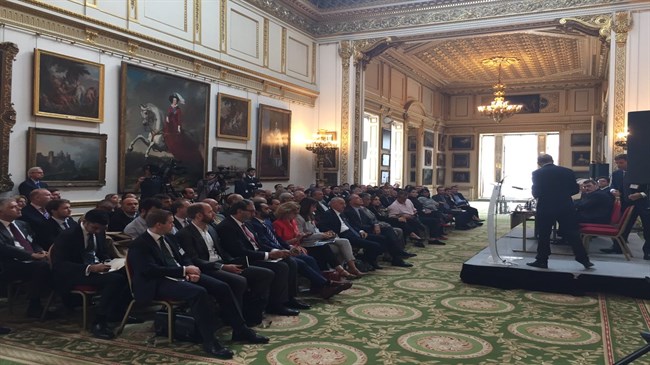
UK’s Quercus seals Iran’s €500 million solar deal
September 20, 2017 - UK renewables investor Quercus signed a deal worth over half a billion euros to build and operate a 600-megawatt (MW) solar farm in Iran, the company said on Wednesday.
The work located in central Iran is expected to take three years, with the project coming online in 100 MW phases every six months, Quercus said of its first project outside Europe, Press TV reported.
Specialist renewable energy investor Quercus will invest over half a billion euros in the solar power project, with construction to start in the first half of 2018, the company’s chief executive told Reuters.
The planned 600-megawatt (MW) plant, located in central Iran, will be the sixth largest globally, behind projects of up to 1.5 gigawatts (GW) in China and India.
Diego Biasi, chief executive of Quercus, which has a track record of investing in renewable energy in Europe, told Reuters the firm had decided to go for such a big project to get an endorsement from Iran’s Ministry of Energy.
“This is a project of national interest, so we got special support. We had enough investors interested so instead of splitting that across smaller projects which wouldn’t have given us the same relationship with the ministry, we decided to go for one,” he said in a phone interview on Tuesday. The hope was this would lead to more solar projects.
Established in 2010, independently-owned Quercus has a portfolio of around 40 renewable energy plants across Europe. The Iran project is its first investment outside Europe, and came in response to client demand, Biasi said.
Under the terms of the agreement signed by Quercus and Iran’s Ministry of Energy, the firm will be responsible for the construction, development and operation of the plant.
Construction is expected to take three years, with each 100 MW standalone lot becoming operational and connecting to the grid every six months, to mitigate the risk for investors.
Rather than investing via a fund structure, Quercus will set up a project company and investors will hold shares via a private placement. It has already attracted interest from private and institutional investors, including sovereign funds, Press TV said.
Hamid Baeidinejad, Iran’s Ambassador to the UK, said the deal with Quercus would support Tehran’s goal to become a “major hub of solar energy serving the region and beyond,” Financial Times reported.
Iran is heavily reliant on natural gas and oil to generate power, but air pollution is driving interest in renewables and Iran has made a commitment to develop 5 GW of new renewable energy capacity by 2020.
Iran’s installed solar energy capacity is currently 53 MW, according to Iranian energy ministry data, but 76 firms have signed deals to study building an extra 932 MW of capacity. Interest has grown since the lifting of international sanctions on Iran in 2016.
“The market is becoming more active on the permit side but on the construction side it hasn’t opened up yet. After this project we think there will be increasing interest from foreign investors,” Biasi said, adding interest was already quite strong.
The project will benefit from bilateral investment treaties that ensure foreign investors are treated the same as local ones. Biasi said there was also a guarantee in the contract with the Ministry of Energy that the electricity would be paid for.
As Quercus has appointed a local partner, Sunir, to help build the plant in conjunction with Spanish firm Bester, it may also benefit from a 15 percent uplift in the feed-in tariff, Biasi said. Under Iran’s renewables regime, the feed-in tariff may be increased by up to 30 percent if local equipment and components are used.
The country’s sunny climate makes it especially suited to solar power generation.
The falling cost of solar panels and wind turbines is making renewable power a more attractive option in the Middle East, Africa and Asia, accelerating the global shift away from fossil fuels.
The Quercus investment was welcomed by Lord Lamont, the former UK chancellor and now trade envoy to Iran, who said it underlined “the importance of developing improved trading relations between the UK and Iran”.
Biasi hoped that its first inroads into Iran would lead to more solar projects.
Before Quercus’s announcement on Wednesday, contracts for about 950 MW of renewable energy projects had been signed.
They are part of the plan to add 1000 MW of renewable energy to the national grid each year in the next five years but the ultimate goal is to establish a 26,000 MW renewable capacity with $60 billion of investment.
Energy producers from Germany, Italy, India, South Korea, Japan, Spain, China, and Switzerland have already visited the country to test the waters for possible investment.
On Friday, Norway’s Scatec Solar was reported to be in talks to generate 120 megawatts of solar power in Iran, which would rise to 500 MW later.
The Oslo-listed firm’s CEO Raymond Carlsen told Reuters that the initial project under discussion would cost $120 million per 100 MW installed.
Iran’s largest solar project is reserved for Qazvin, where the Italians are to set up 1,000 MW of solar capacity with $1.5 billion of investment.
It includes constructing an array of 100 photovoltaic solar power stations over 10 years, each with a nominal capacity of 10 MW.
